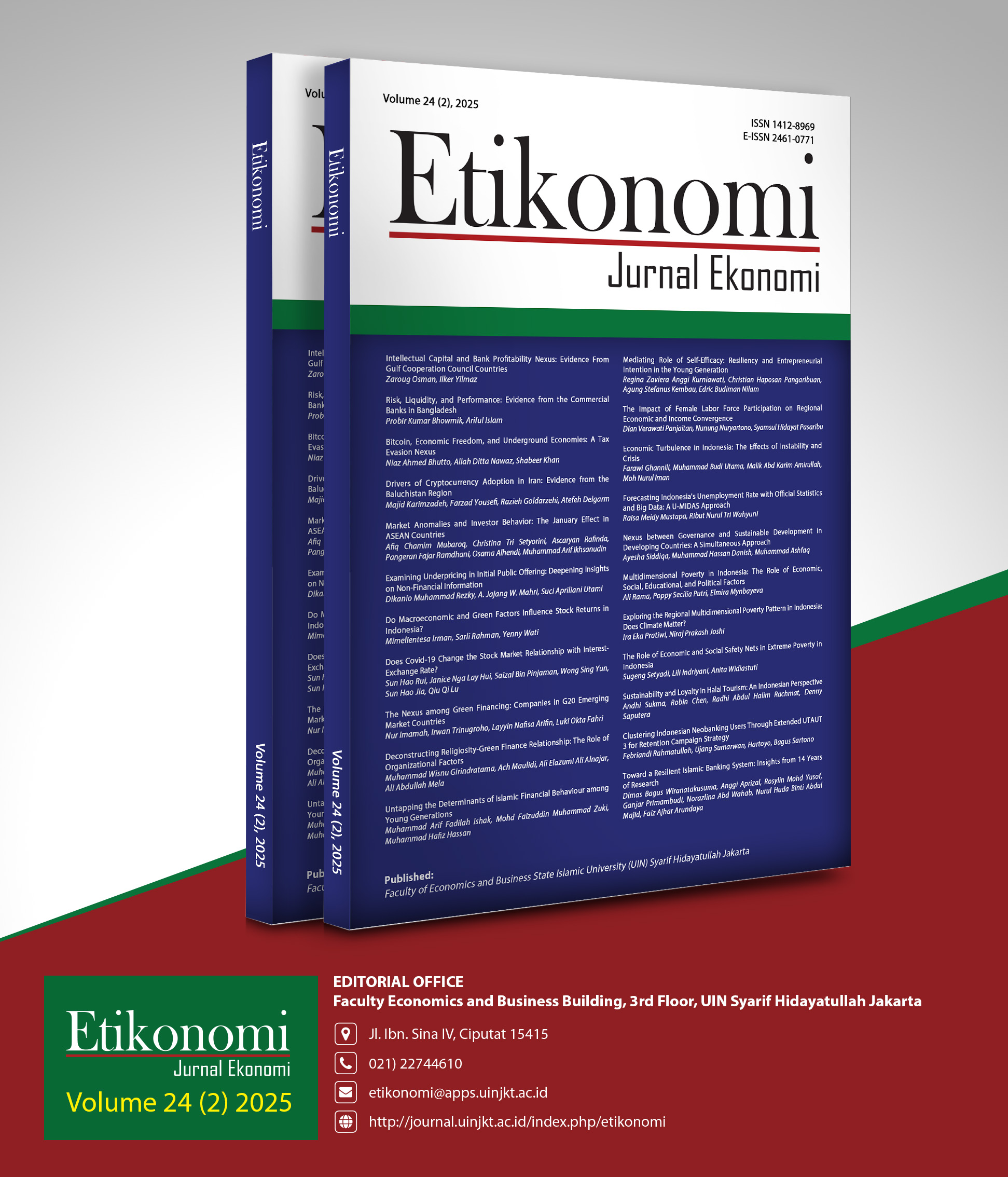Economic Turbulence in Indonesia: The Effects of Instability and Crisis
DOI:
https://doi.org/10.15408/etk.v24i2.44443Keywords:
economic shock, crisis phase, global political tension, structural transformationAbstract
Research Originality: This study presents a novel perspective by examining Indonesia’s economic growth over three crisis periods. It uniquely highlights how global economic uncertainty can strengthen Indonesia’s growth resilience when met with credible domestic policy responses.
Research Objectives: The research investigates the effects of exports, imports, production value, interest rates, economic globalization, exchange rates, and state obligations on Indonesia’s economic growth at constant prices.
Research Methods: Using quarterly time-series data from 1991Q1 to 2024Q1, the study employs a Dummy Variable–Autoregressive Distributed Lag model.
Empirical Result: Exports have a direct negative effect on economic growth but when influenced indirectly by the global crisis and the pandemic, exports can actually contribute to growth. On the other hand, imports directly boost growth, but their impact is negatively affected by the global crisis. Additionally, interest rates support long-term growth but hinder it in the short run; however, crises may moderate this impact positively.
Implications: These findings underscore the need for policymakers to craft dynamic, adaptable economic strategies that can safeguard Indonesia’s growth against future global shocks and uncertainties.
JEL Classification: F41, E32, O53
Downloads
References
Aginta, H., & Someya, M. (2022). Regional Economic Structure and Heterogeneous Effects of Monetary Policy: Evidence From Indonesian Provinces. Journal of Economic Structures, 11(1), 1–25. https://doi.org/10.1186/s40008-021-00260-6.
Azam, M., Emirullah, C., Prabhakar, A. C., & Qayyum Khan, A. (2013). The Role of External Debt in Economic Growth of Indonesia - A Blessing or Burden? World Applied Sciences Journal, 25(8), 1150–1157. https://doi.org/10.5829/idosi.wasj.2013.25.08.11760.
Behera, H., Gunadi, I., & Narayan, B. (2023). COVID-19 Uncertainty, Financial Markets and Monetary Policy Effects in Case of Two Emerging Asian Countries. Economic Analysis and Policy, 78, 173–189. https://doi.org/https://doi.org/10.1016/j.eap.2023.03.001.
Bonciani, D., & Ricci, M. (2020). The International Effects of Global Financial Uncertainty Shocks. Journal of International Money and Finance, 109, 102236. https://doi.org/10.1016/j.jimonfin.2020.102236.
Bordo, M. D., & Meissner, C. M. (2009). Foreign Currency Debt , Financial Crises and Economic Growth : A Long Run Exploration. NBER Working Paper Series, 1–32.
Breitung, J., & Salish, N. (2021). Estimation of Heterogeneous Panels with Systematic Slope Variations. Journal of Econometrics, 220(2), 399–415. https://doi.org/10.1016/j.jeconom.2020.04.007.
Bush, G., & López Noria, G. (2021). Uncertainty and Exchange Rate Volatility: Evidence from Mexico. International Review of Economics and Finance, 75, 704–722. https://doi.org/10.1016/j.iref.2021.04.029.
Cahyadin, M., & Sarmidi, T. (2019). The Impact of Foreign Direct Investment, Labour Force, and External Debt on Economic Growth in Indonesia and Malaysia. Jurnal Ekonomi Malaysia, 53(1), 171–185. https://doi.org/10.17576/JEM-2019-5301-14.
Çamalan, Ö., Hasdemir, E., Omay, T., & Küçüker, M. C. (2025). Comparison of the Performance of Structural Break Tests in Stationary and Nonstationary Series: A New Bootstrap Algorithm. Computational Economics, 65, 3111-3159.
Carrasco, C. A., & Tovar-García, E. D. (2021). Trade and Growth in Developing Countries: the Role of Export Composition, Import Composition and Export Diversification. Economic Change and Restructuring, 54(4), 919–941.
Céspedes, L. F., Chang, R., & Velasco, A. (2020). The Macroeconomics of a Pandemic: A Minimalist Model. Journal of Chemical Information and Modeling, 53(9), 1–26.
Claveria, O. (2022). Global Economic Uncertainty and Suicide: Worldwide Evidence. Social Science and Medicine, 305, 115041. https://doi.org/10.1016/j.socscimed.2022.115041.
Dai, P. F., Xiong, X., & Zhou, W. X. (2021). A Global Economic Policy Uncertainty Index From Principal Component Analysis. Finance Research Letters, 40, 101686. https://doi.org/10.1016/j.frl.2020.101686.
Demir, E., & Danisman, G. O. (2021). The Impact of Economic Uncertainty and Geopolitical Risks on Bank Credit. North American Journal of Economics and Finance, 57, 101444. https://doi.org/10.1016/j.najef.2021.101444.
Desdiani, N. A., Sabrina, S., Husna, M., Budiman, A. C., Afifi, F. A. R., & Halimatussadiah, A. (2022). Local Budget Resilience in Times of COVID-19 Crisis: Evidence from Indonesia. Economies, 10(5). https://doi.org/10.3390/economies10050108.
Dutu, R. (2016). Why Has Economic Growth Slowed Down in Indonesia? An Investigation into The Indonesian Business Cycle Using an Estimated DSGE Model. Journal of Asian Economics, 45, 46–55. https://doi.org/10.1016/j.asieco.2016.06.003.
Elfaki, K. E., Handoyo, R. D., & Ibrahim, K. H. (2021). The Impact of Industrialization, Trade Openness, Financial Development, and Energy Consumption on Economic Growth in Indonesia. Economies, 9(4), 174.
Fazelabdolabadi, B. (2019). Uncertainty and Energy-Sector Equity Returns in Iran: a Bayesian And Quasi-Monte Carlo Time-Varying Analysis. Financial Innovation, 5(1). https://doi.org/10.1186/s40854-019-0128-2
Ghannili, F., & Choiri, M. (2024). The Impact of Key Sectors on Economic Growth: A Cross-Country Analysis. Jurnal Ekonomi Pembangunan, 22, 263–278. https://doi.org/10.29259/jep.v22i2.23133
Ghannili, F., & Lucky, M. P. (2024). The Effectiveness of Remittances from Migrant Workers in Overcoming Poverty in Developing Asian Countries. Journal of Risk Analysis and Crisis Response, 14(4), 453–471. https://doi.org/10.54560/jracr.v14i4.557.
Ghazouani, T., Boukhatem, J., & Yan Sam, C. (2020). Causal Interactions Between Trade Openness, Renewable Electricity Consumption, and Economic Growth in Asia-Pacific Countries: Fresh Evidence From a Bootstrap ARDL Approach. Renewable and Sustainable Energy Reviews, 133, 110094. https://doi.org/10.1016/j.rser.2020.110094.
Gonese, D., Tsegaye, A., Khumalo, S. A., & Kapingura, F. M. (2023). Trade Openness and Non-Income Poverty in Southern African Development Community (SADC) Countries: A Panel Autoregressive Distributive Lag (ARDL) Analysis. Cogent Economics and Finance, 11(2), 2242668. https://doi.org/10.1080/23322039.2023.2242668.
Handoyo, R. D., Erlando, A., & Astutik, N. T. (2020). Analysis of Twin Deficits Hypothesis in Indonesia and Its Impact on Financial Crisis. Heliyon, 6(1), e03248. https://doi.org/10.1016/j.heliyon.2020.e03248.
Hatmanu, M., Cautisanu, C., & Ifrim, M. (2020). The Impact of Interest Rate, Exchange Rate and European Business Climate on Economic Growth in Romania: An ARDL Approach with Structural Breaks. Sustainability, 12(7), 2798.
Hidthiir, M. H. bin, Ahmad, Z., Junoh, M. Z. M., & Yusof, M. F. Bin. (2024). Dynamics of Economic Growth in ASEAN-5 Countries: A Panel ARDL Approach. Discover Sustainability, 5(1). https://doi.org/10.1007/s43621-024-00351-x.
Mohamad, A., Sifat, I. M., Mohd Thas Thaker, H., & Noor, A. M. (2020). On IMF Debt and Capital Control: Evidence from Malaysia, Thailand, Indonesia, the Philippines and South Korea. Journal of Financial Regulation and Compliance, 29(2), 143–162. https://doi.org/10.1108/JFRC-08-2019-0108.
Nasreen, S., & Anwar, S. (2014). Causal Relationship Between Trade Openness, Economic Growth and Energy Consumption: a Panel Data Analysis of Asian Countries. Energy Policy, 69, 82–91. https://doi.org/10.1016/j.enpol.2014.02.009.
Nathaniel, S. P., Murshed, M., & Bassim, M. (2021). The Nexus Between Economic Growth, Energy Use, International Trade and Ecological Footprints: The Role of Environmental Regulations in N11 Countries. Energy, Ecology and Environment, 6(6), 496–512. https://doi.org/10.1007/s40974-020-00205-y.
Nguyen, C. P., & Lee, G. S. (2021). Uncertainty, Financial Development, and FDI Inflows: Global Evidence. Economic Modelling, 99, 105473. https://doi.org/10.1016/j.econmod.2021.02.014.
Nugraha, A. J. (2020). Regional Disparity in Western and Eastern Indonesia. International Journal of Economics and Business Administration, VIII(Issue 4), 101–110.
Rahman, M. M. (2021). The Dynamic Nexus of Energy Consumption, International Trade and Economic Growth In BRICS and ASEAN Countries: A Panel Causality Test. Energy, 229, 120679. https://doi.org/10.1016/j.energy.2021.120679
Setyawan, D. (2020). Energy Efficiency in Indonesia's Manufacturing Industry: A Perspective From Log Mean Divisia Index Decomposition Analysis. Sustainable Environment Research, 30, 12. https://doi.org/10.1186/s42834-020-00053-9.
Silva, P. H. N., & de Araújo, J. M. (2023). Inflation, Perception of Economic Uncertainty and COVID-19: Evidence From Central Bank Communication. Central Bank Review, 23(1), 100108. https://doi.org/10.1016/j.cbrev.2023.100108.
Sudarma, I. M., & Yasa, I. N. A. (2021). The Contribution of External Debt to Economic Growth: An Empirical Investigation in Indonesia. Journal of Asian Finance, Economics and Business, 8(10), 11–17. https://doi.org/10.13106/jafeb.2021.vol8.no10.0011.
Sunde, T. (2017). Foreign Direct Investment, Exports and Economic Growth: ADRL and Causality Analysis for South Africa. Research in International Business and Finance, 41, 434–444. https://doi.org/10.1016/j.ribaf.2017.04.035.
Sutarjo, Murti, W., & Saleh, S. (2021). The Effect of Export Import, Inflation, Interest Rates, and Exchange Rates Against Indonesia’s Economic Growth. International Journal of Business, Economics & Management, 4(2), 449–460.
Thorbecke, W. (2023). Sectoral Evidence on Indonesian Economic Performance After The Pandemic. Asia and the Global Economy, 3(2), 100069. https://doi.org/10.1016/j.aglobe.2023.100069.
Tinungki, G. M., Robiyanto, R., & Hartono, P. G. (2022). The Effect of COVID-19 Pandemic on Corporate Dividend Policy in Indonesia: The Static and Dynamic Panel Data Approaches. Economies, 10(1). https://doi.org/10.3390/economies10010011.
Triatmanto, B., Bawono, S., & Wahyuni, N. (2023). The contribution and Influence of Total External Debt, FDI, and HCI on Economic Growth in Indonesia, Thailand, Vietnam, and Philippines. Research in Globalization, 7, 100163. https://doi.org/10.1016/j.resglo.2023.100163.
Ugurlu, S. (2024). Do Investments Have an Impact on Reducing Poverty? ARDL Approach. Akademik Araştırmalar ve Çalışmalar Dergisi (AKAD), 16(30), 121–137. https://doi.org/10.20990/kilisiibfakademik.1437867.
Van Der Eng, P. (2010). The Sources of Long-Term Economic Growth in Indonesia, 1880-2008. Explorations in Economic History, 47(3), 294–309. https://doi.org/10.1016/j.eeh.2009.08.004.
Were, M. (2015). Differential Effects of Trade on Economic Growth and Investment: a Cross-Country Empirical Investigation. Journal of African Trade, 2(1–2), 71. https://doi.org/10.1016/j.joat.2015.08.002.
Zams, B. M. (2021). Frictions and Empirical Fit in A DSGE Model for Indonesia. Economic Modelling, 99, 105487. https://doi.org/10.1016/j.econmod.2021.03.006.
Downloads
Published
Issue
Section
License
Copyright (c) 2025 farawi ghannili

This work is licensed under a Creative Commons Attribution-ShareAlike 4.0 International License.










